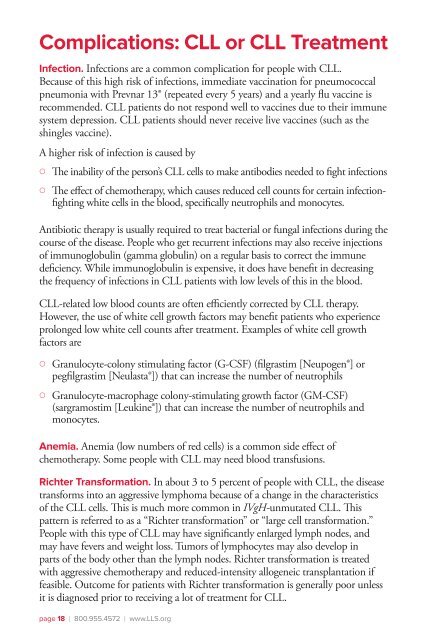Chronic Lymphocytic Leukemia - The Leukemia & Lymphoma Society
Chronic Lymphocytic Leukemia - The Leukemia & Lymphoma Society
Chronic Lymphocytic Leukemia - The Leukemia & Lymphoma Society
Create successful ePaper yourself
Turn your PDF publications into a flip-book with our unique Google optimized e-Paper software.
Complications: CLL or CLL Treatment<br />
Infection. Infections are a common complication for people with CLL.<br />
Because of this high risk of infections, immediate vaccination for pneumococcal<br />
pneumonia with Prevnar 13® (repeated every 5 years) and a yearly flu vaccine is<br />
recommended. CLL patients do not respond well to vaccines due to their immune<br />
system depression. CLL patients should never receive live vaccines (such as the<br />
shingles vaccine).<br />
A higher risk of infection is caused by<br />
{ { <strong>The</strong> inability of the person’s CLL cells to make antibodies needed to fight infections<br />
{ { <strong>The</strong> effect of chemotherapy, which causes reduced cell counts for certain infectionfighting<br />
white cells in the blood, specifically neutrophils and monocytes.<br />
Antibiotic therapy is usually required to treat bacterial or fungal infections during the<br />
course of the disease. People who get recurrent infections may also receive injections<br />
of immunoglobulin (gamma globulin) on a regular basis to correct the immune<br />
deficiency. While immunoglobulin is expensive, it does have benefit in decreasing<br />
the frequency of infections in CLL patients with low levels of this in the blood.<br />
CLL-related low blood counts are often efficiently corrected by CLL therapy.<br />
However, the use of white cell growth factors may benefit patients who experience<br />
prolonged low white cell counts after treatment. Examples of white cell growth<br />
factors are<br />
{ { Granulocyte-colony stimulating factor (G-CSF) (filgrastim [Neupogen®] or<br />
pegfilgrastim [Neulasta®]) that can increase the number of neutrophils<br />
{ { Granulocyte-macrophage colony-stimulating growth factor (GM-CSF)<br />
(sargramostim [Leukine®]) that can increase the number of neutrophils and<br />
monocytes.<br />
Anemia. Anemia (low numbers of red cells) is a common side effect of<br />
chemotherapy. Some people with CLL may need blood transfusions.<br />
Richter Transformation. In about 3 to 5 percent of people with CLL, the disease<br />
transforms into an aggressive lymphoma because of a change in the characteristics<br />
of the CLL cells. This is much more common in IVgH-unmutated CLL. This<br />
pattern is referred to as a “Richter transformation” or “large cell transformation.”<br />
People with this type of CLL may have significantly enlarged lymph nodes, and<br />
may have fevers and weight loss. Tumors of lymphocytes may also develop in<br />
parts of the body other than the lymph nodes. Richter transformation is treated<br />
with aggressive chemotherapy and reduced-intensity allogeneic transplantation if<br />
feasible. Outcome for patients with Richter transformation is generally poor unless<br />
it is diagnosed prior to receiving a lot of treatment for CLL.<br />
page 18 I 800.955.4572 I www.LLS.org

















